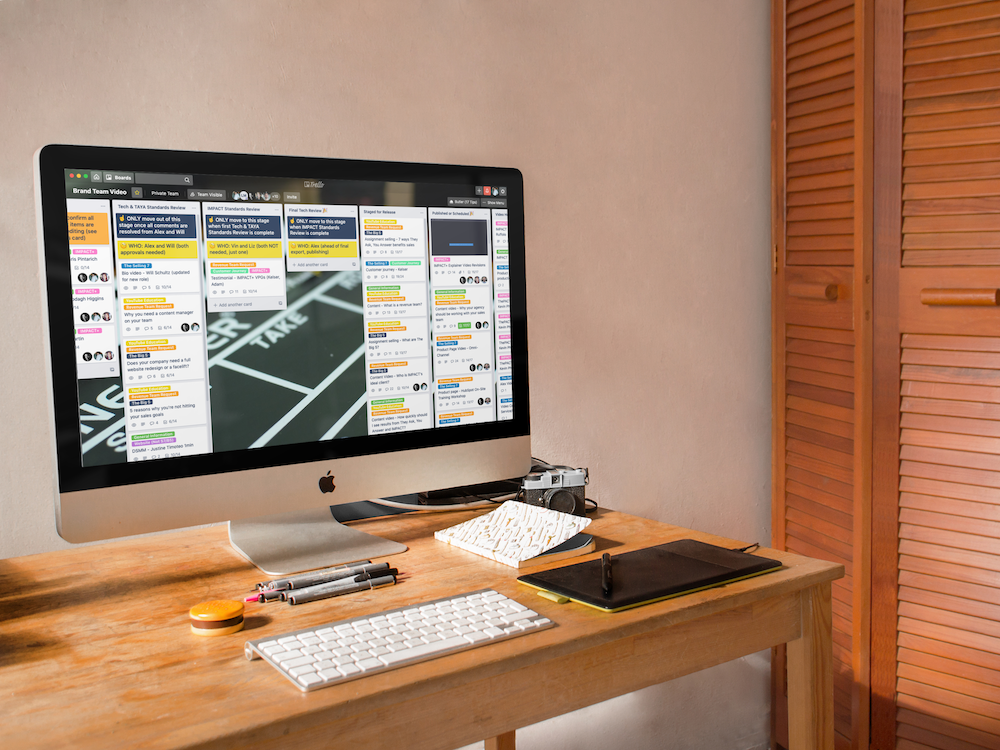Join 40,000+ sales and marketing pros who receive our weekly newsletter.
Get the most relevant, actionable digital sales and marketing insights you need to make smarter decisions faster... all in under five minutes.
How to use Trello for a video marketing strategy
- Build your video strategy outside of Trello in a spreadsheet or other planning document
- Set the lifecycle stages within Trello as their own lanes (e.g., scripting in progress, ready for filming, editing, etc.)
- Create labels based on the most relevant needs (e.g., publishing destination, video type)
- Create template(s) for your video types that communicate video-level strategy, reinforce best practices, and support processes
- Communicate to your team how Trello is to be used going forward, with support from relevant team or department leaders
- Use it and constantly reinforce its use with your team members every single day
Greetings and salutations, fellow digital marketers and content strategy wranglers! Welcome to another entry in my series about my tool stack recommendations for developing and executing a holistic written and video content strategy.
A few weeks ago, we began this journey together with a discussion of my bizarre love of peanut butter and jelly sandwiches (they're divine), and how to use Trello to govern your written content strategy.
Today, we're going to hop to the other side of the fence and talk about how to use Trello to manage the production of your company's video marketing strategy.
For those who need a refresher — or if you're just joining this riveting content strategy programming, already in progress — let's start today's conversation by taking a look at my personal tool stack and workflow for developing a holistic business content strategy.
What a content strategy tool stack and workflow should look like (and where Trello fits)
One of the biggest "ah-ha!" moments of my content management career was the realization that, after years of trying in vain to force one single tool or spreadsheet template to satisfy all of my content strategy needs — and treating a written content strategy and a video marketing strategy like two different things — I finally realized I was doing it all wrong.
🔎 Related: How to use Trello for your business' content strategy
Instead of one tool or spreadsheet to rule them all, I landed on this following content strategy workflow and tool stack after months and months of testing:
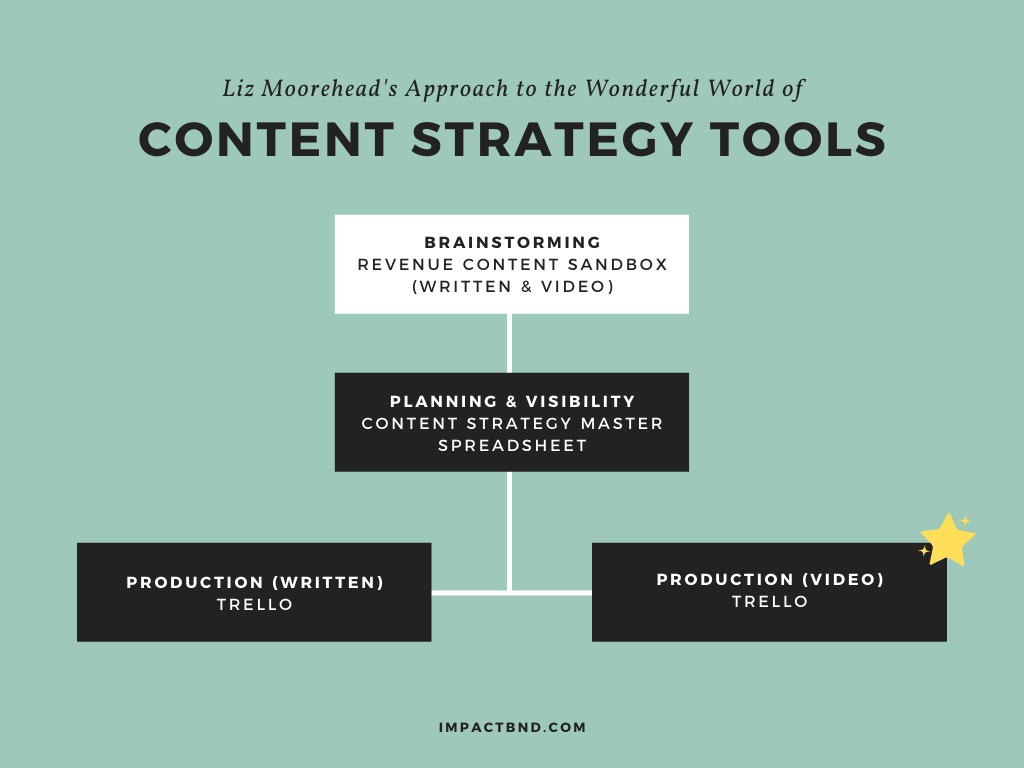
It's so dreamy... 😍
This workflow solves two key challenges:
- It breaks down content strategy development and implementation into key phases, allowing each tool to solve for that specific phase that actually makes the process more seamless, even though there are more tools involved.
- It allows me to run a written and video content strategy as a single entity, rather than two separate (hopefully parallel) content strategies endlessly jockeying for position and priority.
There are three key stages (and corresponding tools) in this content strategy model — brainstorming, planning, and production.
Brainstorming
This is done with our revenue team. For my revenue team content brainstorms, I use our sales content sandbox tool, which allows sales members to suggest and upvote topics they deem to be the most urgent.
🔎 Related: What the heck is a revenue team?
This phase is the genesis of both written and video content requests, as revenue team members have the option to have a piece of content developed as a blog article, video, or both. So, you're not left having to run two separate brainstorming sessions based on the type of content.
On top of that, it allows you to seamlessly connect the dots between content topics that need to exist in written format and video.
Planning
In this stage, I synthesize all of the priorities I've gathered from the revenue team and our director of demand generation in our content strategy master spreadsheet.
With the written side of my strategy, this is where I set all of the different optimization and scoping elements for each piece (featured snippet, video guidance, focus keyword, etc.), since we have 50+ subject matter experts and contributors across the company who will be responsible for creating the content we need.
For video, however, what I cover here is much, much simpler:
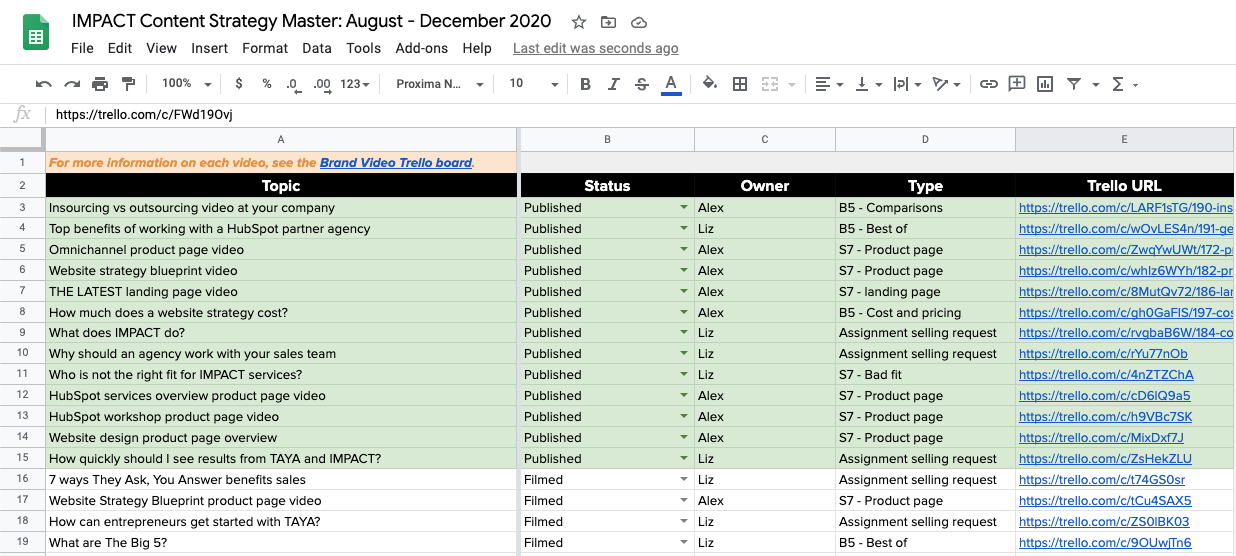
Unlike our written content strategy, we have a small core team of people who are working to produce videos. So, instead of a ton of scoping, I have a tab that provides a clear, succinct overview for leadership of what we're working on, where it fits in the strategy, a high-level view of status, and Trello access to each video in production.
That means my bosses don't need to go cave-diving into Trello to figure out where everything stands, and my sales team isn't (once again) dealing with a cumbersome, many-tabbed spreadsheet to get their content needs met.
Production
Once our strategy is set, it's time to go into production mode, and that's where we bring in Trello. We have one Trello board to manage production of written content and one Trello board to manage production of video content.
We don't have a single Trello board for both written and video content for the following reasons:
- Video and written content have entirely different production stages and lifecycle lengths. There is absolutely zero overlap, so trying to build a single Trello board that doesn't confuse the heck out of everyone just for the sake of saying we have everything in one place creates more problems than it solves.
- There are two different groups of people working in each space. In fact, the written content strategy involves many, many more people than the video content strategy.
Now, let's dig into Trello...
Use what you see here as a guide (especially since it's free!)
One of the best things about Trello is how you can customize it endlessly to suit your needs. So, everything that I show you in the following examples is set up to reflect our best practices and specific processes.
As an added bonus, everything I'm going to show you is using the 100% free version of Trello, although there are plenty of paid "power-ups" you can purchase or higher levels of plans that will give you more features.
With the coronavirus (COVID-19) pandemic still creating issues for many of us, I thought it would be nice to start this conversation from a place of "free," where you don't have to ask for any budget increases to implement what I am going to show you in this article.
Also, what the heck is Trello?
If you haven't heard of Trello up until this very moment, your life is about to get so much better:
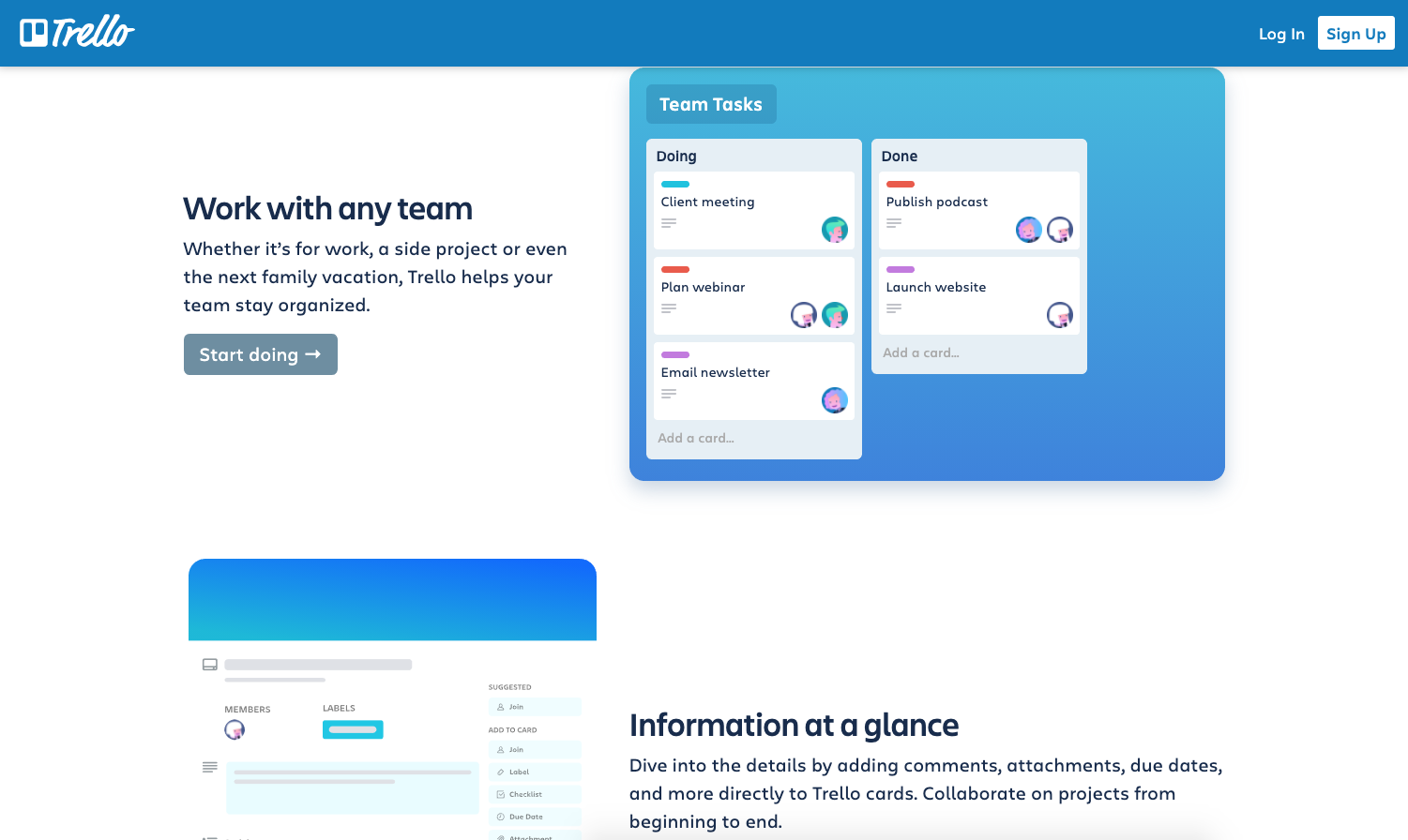
It's a super intuitive organization tool you can use for project management, planning events (Katie is using it to plan her wedding!), running campaigns, and more. Of course, in a surprise to no one, one of my favorite ways to use Trello is for our content strategies.
Create content production stages in Trello
Most written content pieces, like blogs, follow a basic production process:
- A video is requested via a revenue content brainstorm. This video is either standalone (like a landing page video or 80% video) or it's associated with a piece of content (a blog article) that has also been requested.
- Planning is completed for a video, which includes choosing who will be on the video, where it will be filmed, final publishing destinations (YouTube, in an article, on a website page, etc.), and so on.
- The video is scripted.
- The video is filmed.
- The video is edited.
- The video goes through specific rounds of revisions.
- The video is approved.
- The video is staged for release.
- The video is actually published.
Just like with your written content strategy, define and document what your specific phases are before you go to build them in Trello. Although your building time in Trello may show you that you have more stages in your production process than you think, so expect it to evolve.
🎓 Free IMPACT+ course: How to create a video sales and marketing strategy
One thing I will tell you from experience is that you'll have an urge to streamline or condense stages, as you're building. Don't do this. Our video board started with 12 stages, because it seemed more "streamlined," but it's since expanded to 18 stages.
While it sounds counterintuitive, the workflow on the Trello board is now much more seamless and efficient with more specific stages, rather than fewer "catchall" stages.
Here's a snapshot of what part of our board looks like:
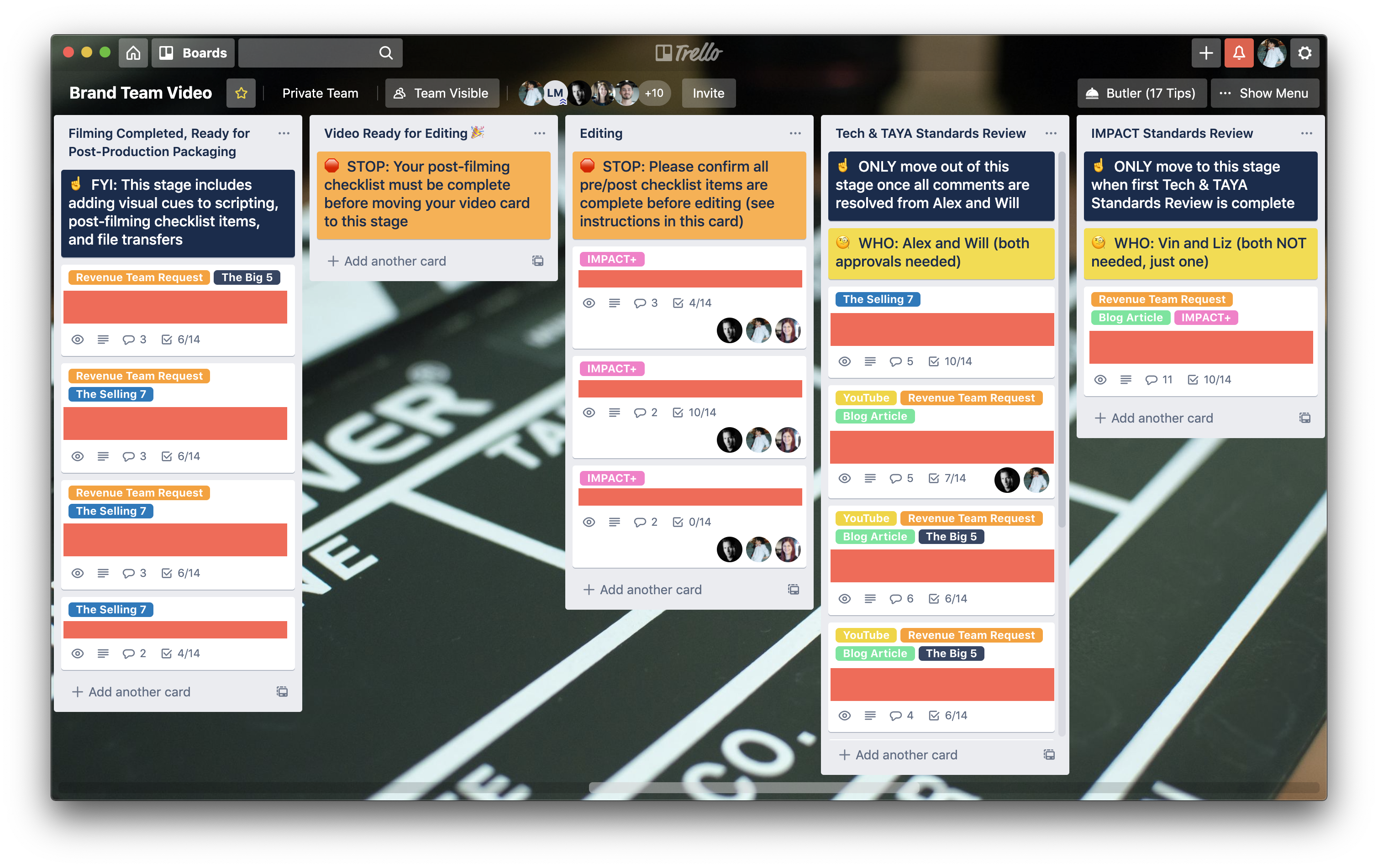
The lanes we have set up in Trello for our video marketing strategy are:
- Video dugout (videos that are requested but don't have a time-bound plan yet)
- Backlog bullpen (request videos that have a start that are not in the same week, but within the same month)
- On deck to film (videos that are going to be filmed that week)
- Scripting in progress
- Visual inspiration (for videos with animation, or if required)
- Storyboarding (for videos with animation, or if required)
- Ready for filming
- Filming completed, ready for post-production packaging
- Video ready for editing
- Editing
- Tech and TAYA standards review
- IMPACT standards review
- Final tech review
- Requires reshoots
- Staged for release
- Published or scheduled
- Video heaven (abandoned video projects)
Originally, we had just one lane for "content under review," but with the specific phases of review (with specific stakeholders) it got confusing with lots of back and forth in the comments, and hard to keep track of. Ever since I broke it up into three phases, all of our lives have gotten much easier.
I also have the first lane as a resources and templates section, so everyone is clear on how the board is supposed to function:
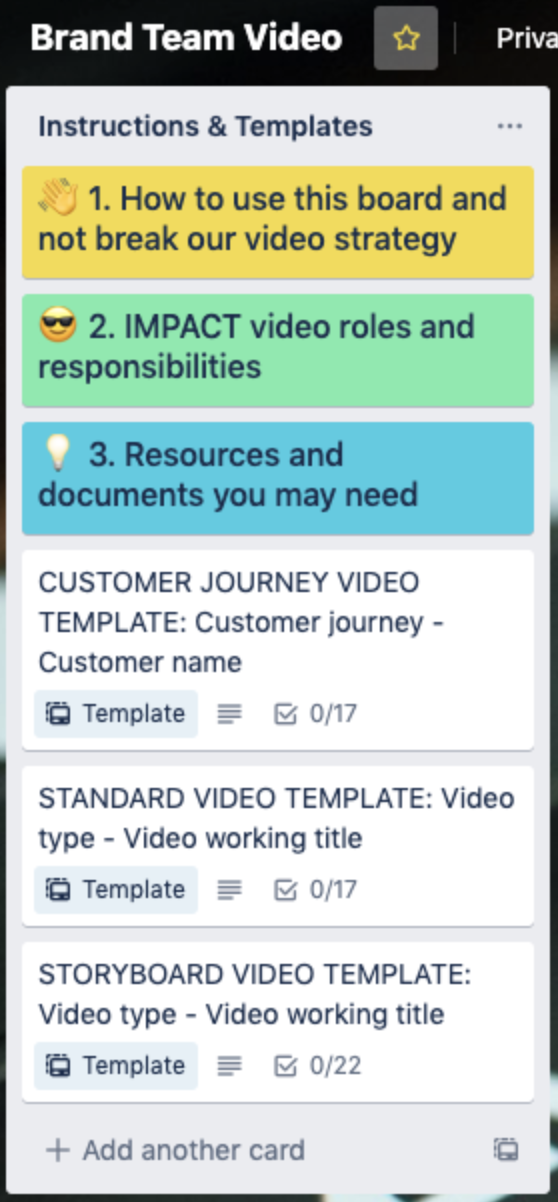
Using labels for your content strategy in Trello
I love Trello labels. They're an outstanding way in the video marketing strategy to denote things folks will want to know at a glance:
- Type of video
- Publishing destinations
- Special project needs
- If there's an issue with the project
Here are the labels we have for our video marketing strategy in Trello:
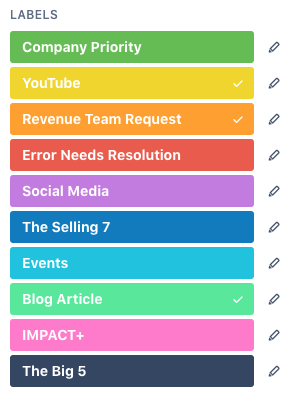
These labels not only adhere to and reinforce They Ask, You Answer best practices, they also help me keep track of special projects, priorities, and errors throughout the process, without me having to click into each card.
Reinforcing process and best practices with "cover cards" in Trello
Creating video is an intricate, involved process with lots of different people having their hands on a single video. For example, five people (at minimum) have their hands on every single video we produce.
So, since I know we're all busy folks, I've started using cover cards at the top of specific Trello lanes, as needed, to make it easy for people to remember what they're supposed to do or who is to be involved during specific stages:

I have reminders of what needs to be completed.

I also use them to be very clear about the revisions process. This may seem like overkill, but trust me, so many problems went away when I broke the revisions process apart into the three separate stages and included these notes.
To create these header cards, create a standard card in Trello:
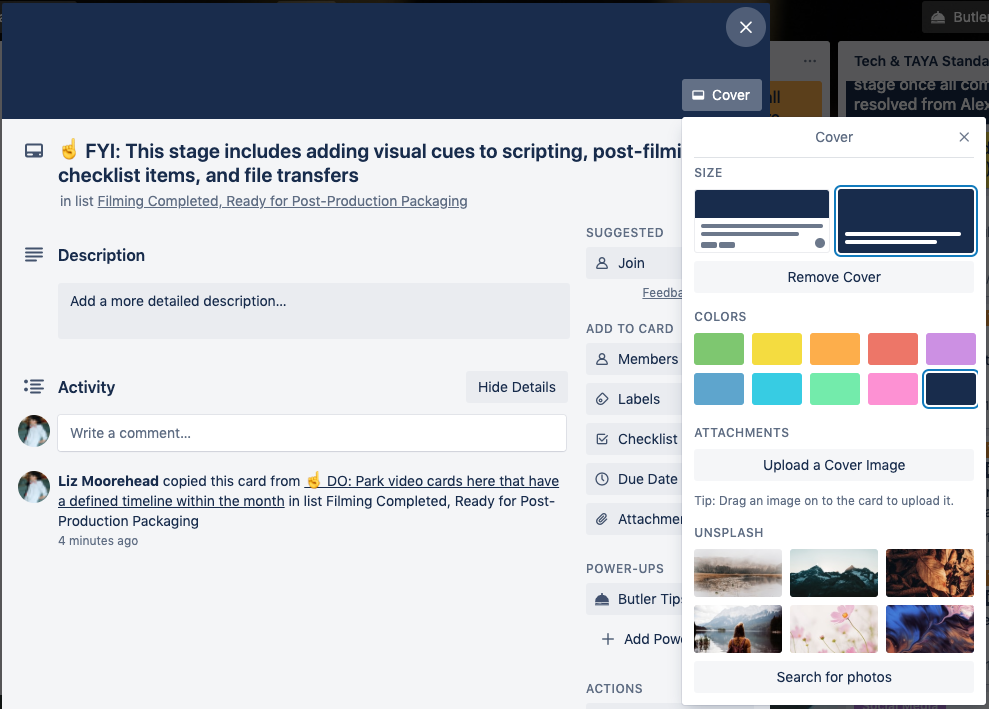
Then, click on "cover" in the "add to card" section. If you want the setup I have, choose a color (although you can also choose an image), select the right cover option, and then add an emoji of your choice to the heading.
Create Trello card templates for your content
Once more with feeling, this is one of my favorite things about Trello. In order to publish a piece of high-quality, revenue-generating content, you can't just build out the right stages. You need to maximize Trello in such a way that it reinforces strategic best practices and gives your content creators everything they need in one place to be successful.
Now, here's how we do it at IMPACT:
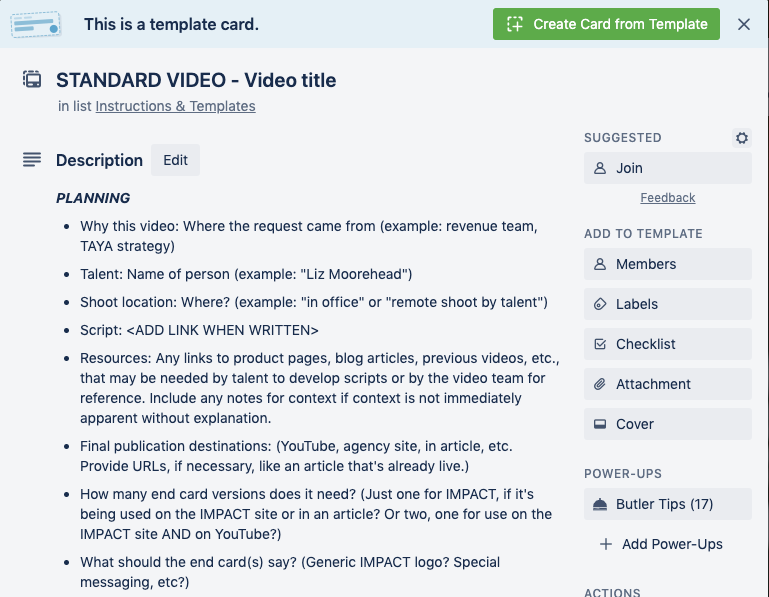
The top part of the card has all of the strategic notes we need to complete for the planning of a video before filming.
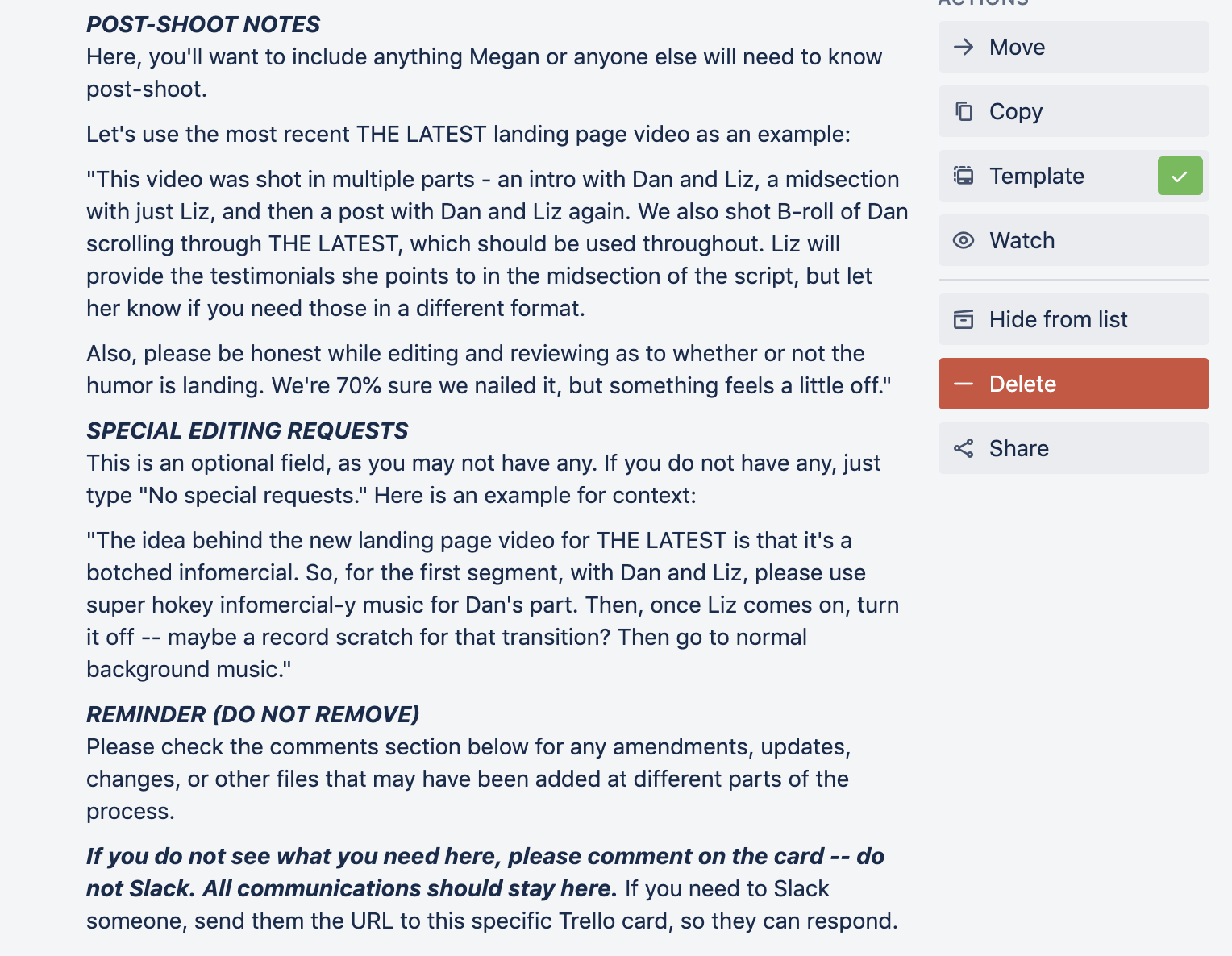
Beneath that, I've built into the template a section of notes for after filming is completed. Anything your video editor will need to know about filming, special requests, and any other important pieces of information.
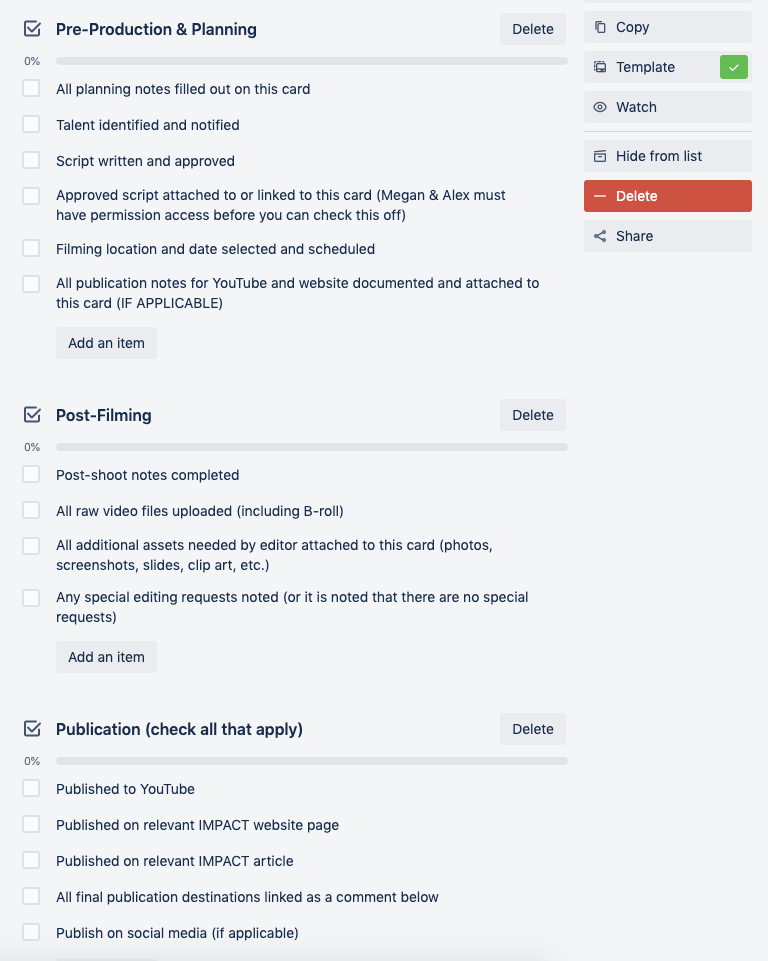
Finally, I have three sets of checklists for pre-production, post-production packaging (where we prep the raw footage, post-shoot notes, etc., for the editor) and the different phases of publication.
Here is what an active video card for a real video we shot looked like once it was filled out with the right information:
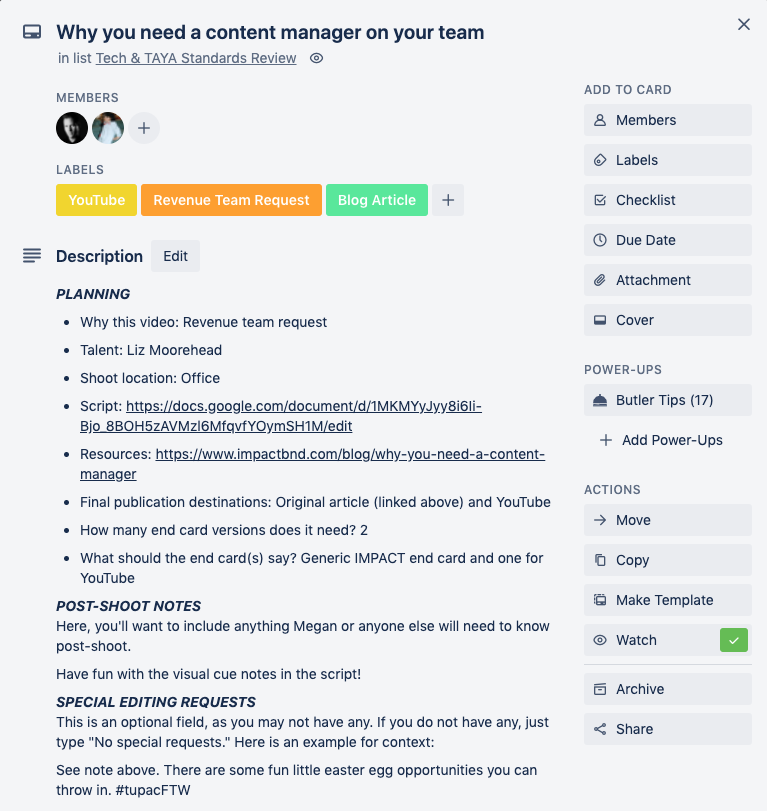
Engage in comments in Trello for your content
Just like with your written content strategy, the comments section of your Trello board should be very active, just like ours are...
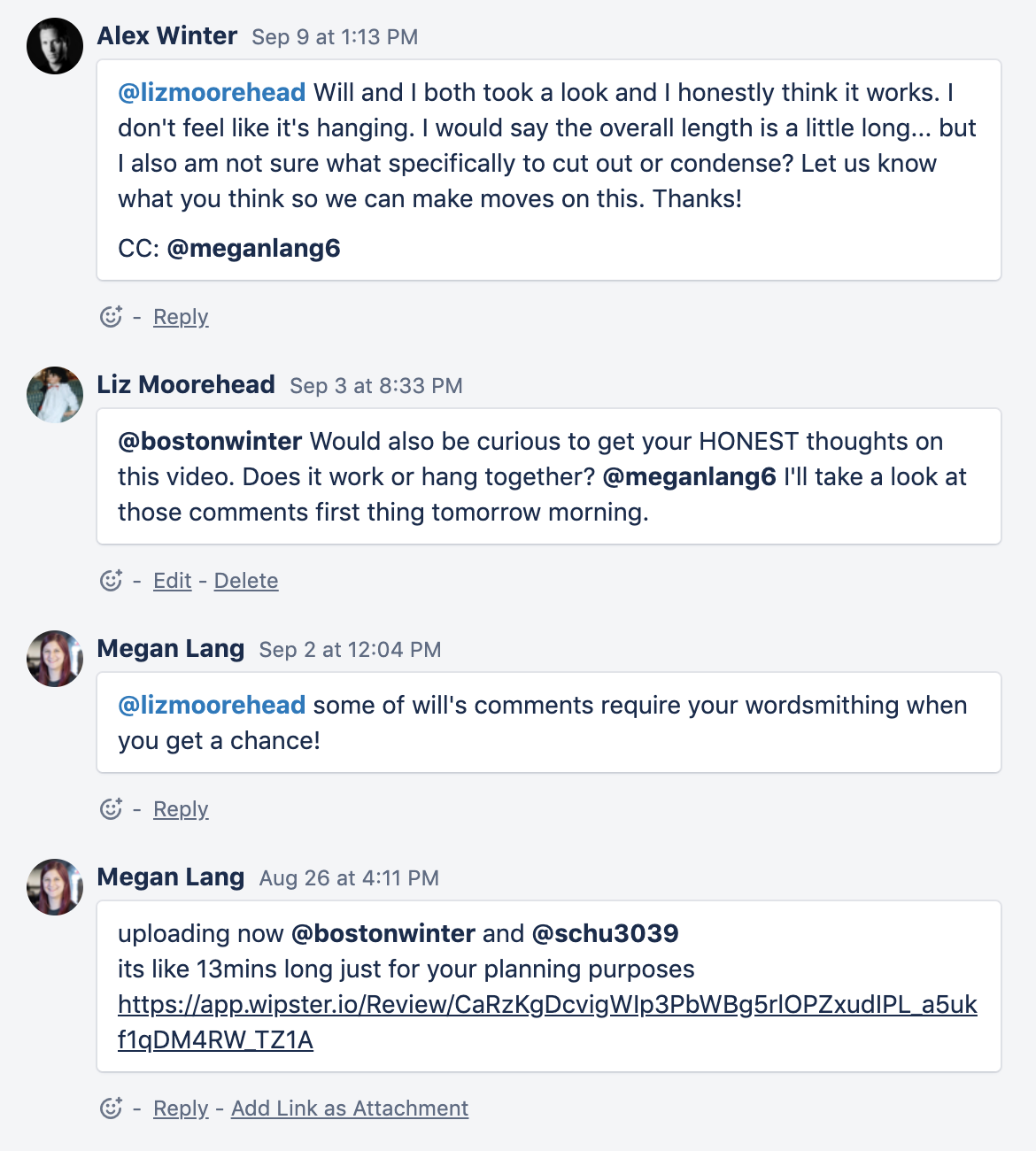
The goal is to keep ALL conversation about a single video in one place, so no conversations happen in Slack or over email, where other stakeholders may accidentally end up out of the loop.
Consistency is absolutely key to adoption
This all looks and sounds lovely. But it's only effective if you get people using it. Unfortunately, even if people love what you've built in theory, getting everyone using it seamlessly and consistently isn't always easy.
For instance, let's say someone is not using Trello like they should be. Maybe they're not using the checklists, cards are lingering, or there's some other issue.
To resolve this, I'll never Slack or email questions about the status of a video. Instead, I'll make a comment in Trello asking for a status update, and then I'll Slack that person the link to that card with a friendly note saying, "Hey, can you follow up on this comment I had about this video?"
Don't be a jerk about it, but understand that the more you explicitly reinforce the use of Trello has your hub for your video strategy, the better off you'll be.
The more you communicate through your actions, however, that Trello use is not the rule by living outside of it yourself for the sake of "convenience" the more you'll undermine your ability to establish Trello as the habit you need it to be for others.
"But Liz, how do we know what our company's video marketing strategy should include?"
That's a great question. While Trello can help you execute a video marketing strategy for your company, it's not the strategy itself. Here are a few resources to help you get started in creating your video marketing strategy:
- What is a revenue team? This article will teach you the framework of how we develop the ideas for our written and video content strategies.
- The Selling 7 sales and marketing videos guaranteed to get results. A primer on the seven types of videos your company absolutely must be creating.
- Our free video sales and marketing strategy course in IMPACT+. Seriously, consider this a must-take online training if you're a digital marketer, content manager, or business leader who wants to use video.
Stay tuned! There are so many ways to use Trello. So, soon I'll be sharing how to supercharge your use of Trello with paid add-ons. (Again, everything above was developed using only the free version of Trello because, hey... we're all watching our budgets right now.)
Free Assessment:

